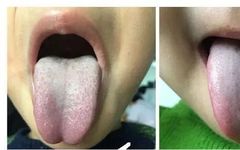The tongue surface of a normal person has a thin, white, and moist coating, known as the tongue coating. It is composed of shed keratinized epithelium, saliva, bacteria, food debris, and exuded white blood cells. Under normal circumstances, due to chewing and swallowing actions, as well as the rinsing effect of saliva and food, the substances on the tongue surface are continuously cleared, resulting in only a thin layer of tongue coating.
When ill, if food intake is reduced or only soft food is consumed, leading to decreased chewing and tongue movement, or if saliva secretion decreases, the tongue coating becomes thicker. In healthy individuals, the tongue coating is generally thin and evenly spread across the tongue surface, slightly thicker in the middle and at the root.
1. TCM Theory
The tongue coating is generated by the Stomach Qi, and since all the organs derive their Qi from the stomach, changes in the tongue coating can reflect the cold, heat, deficiency, and excess of the organs, as well as the nature of the pathogenic factors and the depth of the disease. The observation of the tongue coating includes examining its color and texture.
Coating Color:The color of the tongue coating can indicate pathological conditions, with common pathological colors being white, yellow, and gray-black. Sometimes, a green coating may occur (often transforming from white coating, commonly seen in warm epidemics and damp-heat conditions, indicating damp-heat accumulation), and a moldy coating (red with black and yellow, often seen in cases of food stagnation or prolonged internal heat, indicating chronic damp-heat conditions).
2. Coating Texture
The texture of the tongue coating can be categorized as follows:
1. Presence or Absence of Coating: A normal tongue has a thin white coating generated by Stomach Qi. In the course of illness, the transition from having coating to none indicates a deficiency of Stomach Qi and a gradual decline of righteous Qi; however, if the coating peels off and then a thin white coating reappears, it indicates that the pathogenic factor has retreated and the righteous Qi is gradually recovering.
2. Thickness of Coating:If the tongue body is faintly visible through the coating, it is considered thin coating; if not, it is thick coating. The thickness of the coating can determine the severity of the pathogenic factor and the depth of the disease. Thin coating indicates exterior syndrome or internal Qi stagnation. Thick coating indicates phlegm-dampness, dampness, or food stagnation. When the coating changes from thin to thick, it indicates that the pathogenic factor has penetrated inward, and the disease is progressing; when it changes from thick to thin, it indicates that the pathogenic factor is retreating and the righteous Qi is prevailing.
3. Moisture or Dryness of Coating: The moisture level of the tongue coating can reflect changes in body fluids. If the tongue surface is moist and moderately dry, it indicates a normal tongue appearance, even if there is illness and body fluids are not harmed; if it feels wet and slippery, it is termed slippery coating, often indicating cold or dampness, or yang deficiency with water retention. If the tongue surface appears dry and feels devoid of moisture, it indicates dry coating, often due to excessive heat damaging body fluids, yin deficiency, or Qi failing to transform fluids.
4. Distribution of Coating: The distribution of the coating on the tongue can vary. If the coating covers the entire tongue, it is termed full coating. If the coating is localized to a specific area of the tongue, it is termed partial coating. Observing the distribution can help determine the location of the disease. Full coating indicates scattered pathogenic Qi, often a sign of damp-phlegm obstructing the middle burner; if the coating is localized to one side of the tongue, it indicates that the pathogenic factor is half-exterior and half-interior, or that the disease is in the liver and gallbladder; thick and greasy coating at the root often indicates phlegm-dampness or gastrointestinal stagnation.
5. Peeling and Growth of Coating: Changes in the thickness and amount of coating also reflect the progression of pathogenic factors. If the coating increases from thin to thick, it generally indicates that the pathogenic factor is worsening; if it decreases from thick to thin, it indicates that the righteous Qi is gradually recovering and the disease is retreating. Sudden increases or decreases in coating often indicate a rapid change in the condition.
6. True or False Coating: Distinguishing between true and false coating can help assess the severity of the disease and prognosis. The determination of true or false coating is based on whether it is rooted or not. If the coating adheres tightly to the tongue surface and is difficult to scrape off, resembling growth from the tongue body, it is termed true coating or rooted coating. If the coating is not firmly attached, easily scraped off, it is termed false coating or non-rooted coating.
In the early and middle stages of illness, rooted coating is more severe than non-rooted coating; in the later stages, rooted coating is preferable to non-rooted coating. If a thick coating appears to float on the tongue, seemingly non-rooted, but a new layer of coating grows underneath, it indicates a sign of recovery. When distinguishing false coating, three aspects should be noted:
First, if the coating is fully present in the morning and disappears after eating, it is considered false coating, but not necessarily non-rooted; if it diminishes to little or no coating afterward, it indicates internal deficiency.
Second, if there is coating with color that scrapes off easily, it indicates a mild condition; if it scrapes off too easily, it indicates an even milder condition.
Third, if there is thick coating without roots, and it does not regenerate new coating underneath, it indicates that the original Stomach Qi is present, but the subsequent Stomach Qi is deficient and cannot vaporize the gastric fluid. This is often due to excessive consumption of cold medicines damaging yang Qi, or excessive consumption of hot medicines damaging yin fluids.
3. Manifestations of Tongue Coating
1. White Coating: Generally indicates exterior syndrome or cold syndrome. A thin white and moist coating is the normal tongue coating; at the same time, thin white coating also indicates that the disease is at the surface and has not penetrated inward. A thin white coating that is overly slippery is often seen in exterior cold syndrome. A thin white coating that is dry indicates exterior heat syndrome or invasion of dry pathogenic factors. A thick white and dry coating represents damp turbidity transforming into heat and damaging body fluids. A tongue fully covered with white coating that feels moist indicates “powdery white coating“, indicating a febrile disease.
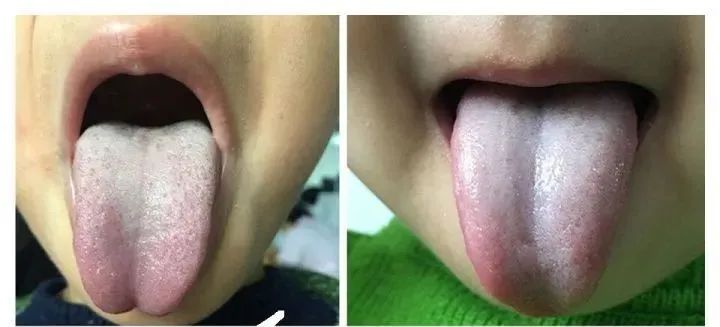
A dry white coating is termed “rough cracked coating“, often seen in warm diseases. A pale tongue with a white and moist coating indicates cold syndrome or cold-damp syndrome. A white, slippery, and greasy coating is seen in cases of internal phlegm-dampness or dampness obstructing the spleen. A white, slippery, and rotten coating indicates heat accumulation in the stomach. If the coating is white like snowflakes and dry, it is termed “snowflake coating“, indicating spleen cold. If the tongue and mouth are covered with a layer of coating, showing moldy coating or ulcerated spots, it indicates a decline in Stomach Qi, and the organs are in a critical state.
2. Yellow Coating: Yellow coating indicates internal heat syndrome. A thin yellow and dry coating indicates excessive internal heat, damaging body fluids. A yellow, dry, and prickly coating with cracks on the tongue indicates extreme internal heat, severely damaging body fluids, and great heat in the organs. A thick and greasy yellow coating often indicates phlegm-heat, food stagnation, or internal damp-heat accumulation. A yellow, slippery, and moist coating indicates a manifestation of yang deficiency.
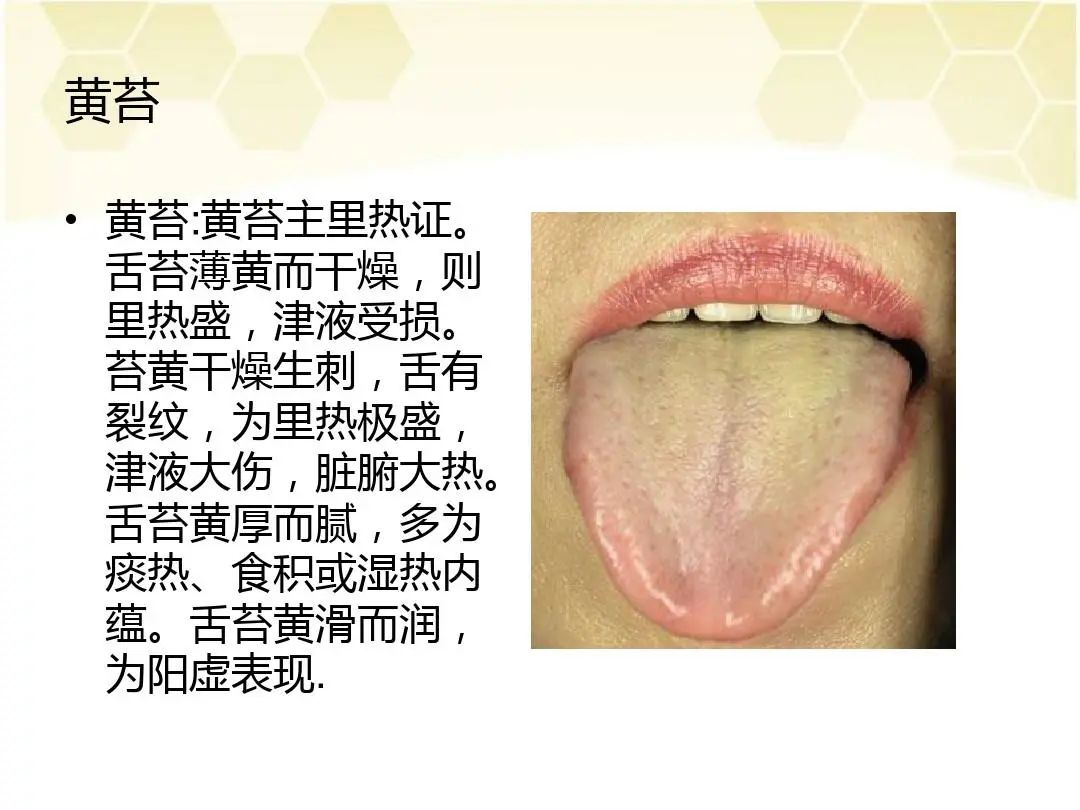
3. Gray Coating: Indicates internal syndrome. A gray, thin, and slippery coating often indicates cold-dampness obstructing internally, or phlegm-dampness retention. A gray and dry coating indicates heat disease or yin deficiency with excessive fire.
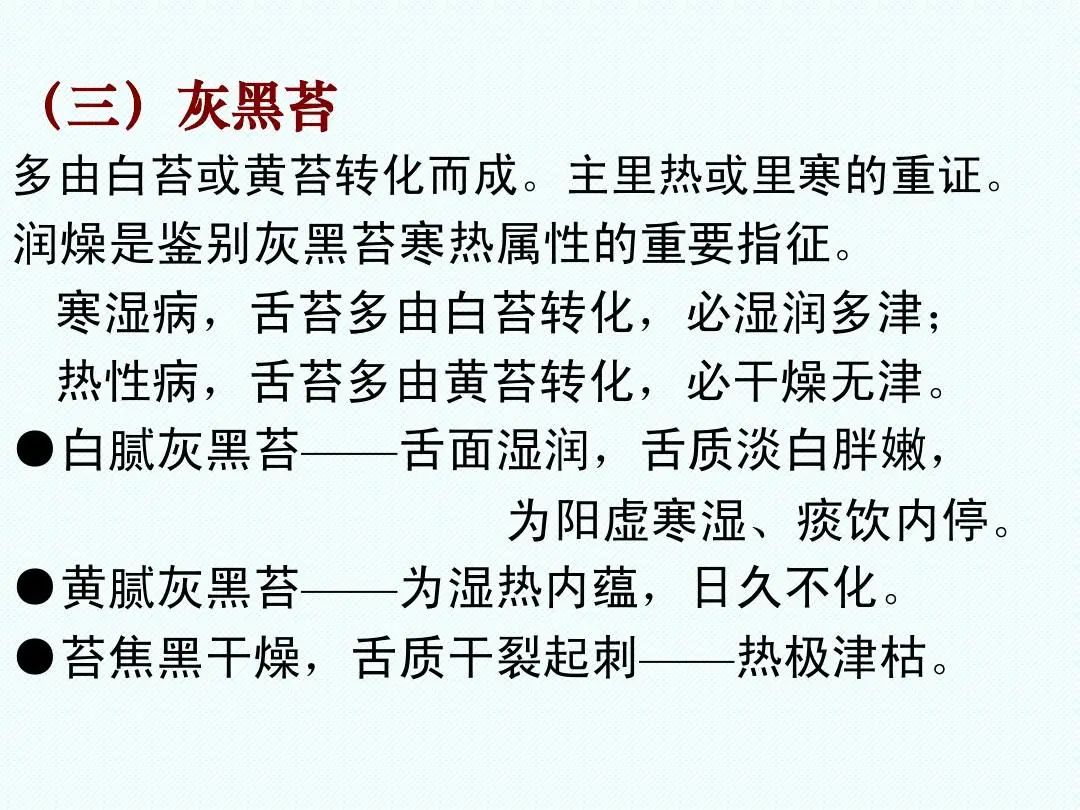
4. Black Coating: Black coating often transforms from yellow or gray coating, indicating a very serious condition. A black and dry coating indicates excessive heat with fluid deficiency. A black and dry coating at the tip of the tongue indicates excessive heart fire. A black and slippery coating indicates extreme yang deficiency and yin cold.
4. Knowledge of Coating Texture
Finally, we discuss the knowledge of observing coating texture. Observing coating texture involves examining the shape and quality of the tongue coating. The main observations include thickness, moisture, greasiness, peeling, rootedness, and distribution.
(1) Thick and Thin Coating:
The thickness of the coating is determined by whether the tongue body is visible or not. If the tongue body can be seen through the coating, it is termed thin coating; otherwise, it is thick coating. Thin coating generally indicates a milder condition; thick coating indicates a more severe condition. In the progression of disease, if the coating changes from thin to thick, it indicates that the pathogenic factor has penetrated inward, and the condition has worsened; if the coating changes from thick to thin, it indicates that the pathogenic factor is retreating, and the condition is improving.
(2) Moist and Dry Coating:
A moist coating with plenty of body fluids indicates that the fluids are not harmed, termed moist coating. A dry coating lacking body fluids is termed dry coating. A dry coating that is yellow indicates excessive stomach heat, damaging body fluids. A dry coating that is black indicates extreme heat damaging yin. If the dry coating is black and prickly, it indicates extreme heat with depleted body fluids.
(3) Greasy and Rotten Coating:
A coating with fine and dense particles, moderately thick at the edges, and difficult to scrape off is termed greasy coating. A coating with larger particles, loose and thick, resembling tofu dregs piled on the tongue surface, and easy to scrape off is termed rotten coating. Greasy coating is often seen in damp turbidity, phlegm-dampness, food stagnation, and damp-heat conditions. Rotten coating indicates food stagnation in the stomach and intestines, phlegm turbidity retention, and ulcerative conditions. A white greasy coating often indicates damp phlegm or spleen yang deficiency. A yellow greasy coating often indicates phlegm-heat or food stagnation transforming into heat. A thick rotten coating often indicates food stagnation in the stomach and intestines. A tongue fully covered with white coating is termed oral thrush, indicating a decline in Stomach Qi.
(4) Peeling Coating:
If the coating that was originally present on the tongue partially or completely disappears, it is termed peeling coating. If the coating completely peels off, it indicates depletion of Stomach Yin and significant damage to Stomach Qi. If the coating partially peels off, with smooth areas devoid of coating, it is termed flower peeling coating, indicating damage to both Stomach Qi and Yin. If the areas where the coating has peeled off are not smooth and have new granular growth, it is termed similar peeling coating, indicating that the patient’s blood and Qi are not continuous. If most of the coating has peeled off, leaving only a small patch, it is termed chicken heart tongue, indicating deficiency of Stomach Qi and Yin. Additionally, if the coating changes from present to absent, it indicates deficiency of Stomach Qi and Yin, with a gradual decline of righteous Qi; if the coating changes from absent to gradually becoming thin white coating, it indicates improvement in the condition.
(5) Rooted and Non-rooted Coating:
If the coating adheres tightly to the tongue surface and is difficult to scrape off, it is termed rooted coating. If the coating appears to be painted on the tongue surface and scrapes off easily, it is termed non-rooted coating. Rooted coating indicates that the patient has Stomach Qi, commonly seen in excess or heat conditions; non-rooted coating indicates that Stomach Qi has declined, seen in deficiency or cold conditions. If there is rooted coating with thin coating, it is considered normal coating, indicating that the righteous Qi is not harmed; if there is non-rooted coating that is thin or thick, scraping it off does not regenerate new coating, it indicates that the righteous Qi is declining.
(6) Full and Partial Coating:
If the coating covers the entire tongue, it is termed full coating. If the coating is only present in a specific part of the tongue, it is termed partial coating. Full coating represents damp-phlegm obstruction in the middle burner. If only the tip of the tongue has coating, it indicates that the pathogenic factor has entered but not deeply, while Stomach Qi is injured. If the tip of the tongue is devoid of coating, but the rest has coating, it indicates stagnation in the intestines or phlegm-dampness. If the coating is biased to the left or right side, it indicates that the pathogenic factor is half-exterior and half-interior, and may also indicate liver-gallbladder damp-heat; if the center of the tongue is devoid of coating, with thick coating at the edges, it indicates yin deficiency, damage to Stomach Qi, or blood deficiency.
5. Disease Differentiation Methods
1. Black Coating Disease Differentiation: The appearance of black coating often indicates a more severe condition, or may be due to excessive use of antibiotics, or poor oral hygiene. Yellow 10 grams of Huang Lian (Coptis chinensis) decoction can be applied to the black coating multiple times a day; if the black coating shortens, softens, and the color lightens or disappears, it indicates that this black coating is due to poor oral hygiene. Otherwise, the cause should be identified.
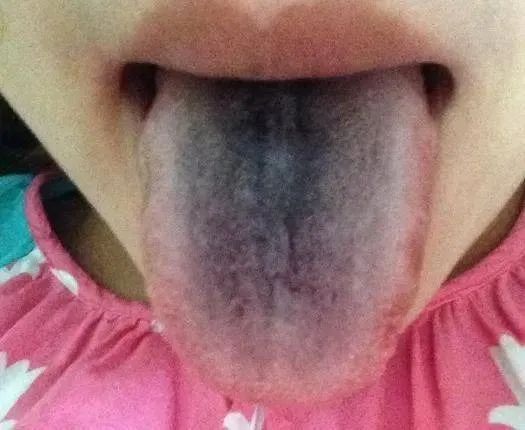
2. Rhombus Peeling Coating Disease Differentiation: If a rhombus-shaped peeling area appears in the center of the tongue, it may indicate the presence of diabetes. If symptoms such as excessive hunger, thirst, and weight loss are also present, it should be taken seriously.
3. Strawberry Tongue Disease Differentiation: If the patient exhibits enlarged and red papillae on the tongue surface, resembling a red strawberry, it is termed strawberry tongue. If accompanied by high fever and the skin develops dense, small red rashes, it may indicate scarlet fever—this condition makes eating painful.
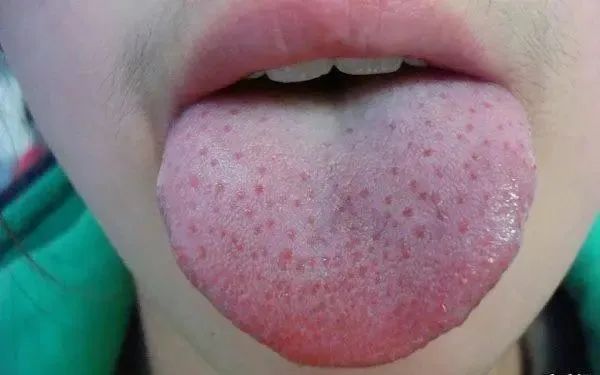
4. Flower Peeling Tongue Coating Disease Differentiation: Flower peeling tongue coating, also known as geographic tongue coating, is characterized by partial peeling of the coating, exposing the red tongue body. In children, this often indicates poor constitution, and these children are often prone to allergic conditions such as asthma and eczema. Children who are picky eaters and do not like fresh vegetables, or those who are malnourished, have intestinal parasites, or frequently catch colds, may also exhibit peeling coating. In adults, this indicates yin deficiency and blood deficiency; if the flower peeling is seen at the tip of the tongue, it indicates heart yin deficiency; if it is seen at the root of the tongue, it indicates liver and kidney yin deficiency.
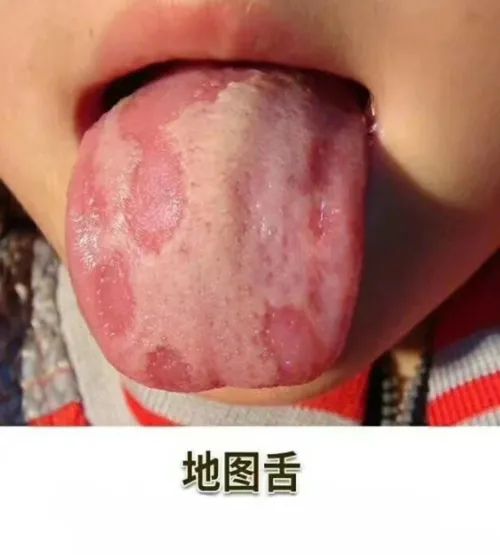
5. Tongue Base Vein Disease Differentiation: If two veins are visible at the base of the tongue, normally only faintly visible, and their diameter exceeds 2.7 mm, with a length exceeding three-fifths of the line connecting the tip of the tongue to the end of the frenulum, it indicates a pathological condition. Sometimes, there may also be bluish-purple spots on the tongue edges or numerous small vascular clusters. This reflects blood stasis in the whole body or in certain organs. Blood tests may often show abnormal indicators such as hematocrit and blood viscosity.
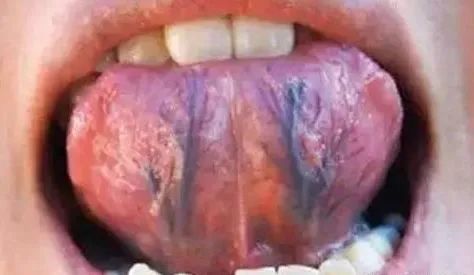
6. Tongue Projection
Extending the tongue also has its nuances; the tongue should be relaxed, the surface flat, and the tip slightly downward, with the mouth opened wide (but not excessively forceful) to fully expose the tongue body. If the tongue is extended too forcefully, or if the tongue body is tense or curled, it can affect the circulation of Qi and blood in the tongue, leading to changes in tongue color or moisture levels.
Observing the tongue should follow a sequence: generally, first observe the tip of the tongue, then the middle, the sides, and finally the root, while also examining the color and texture of the tongue body (tongue quality) and the thickness and color of the coating.
Two key points to observe: tongue diagnosis mainly focuses on changes in the tongue body and coating. What color is the tongue body? Is it plump or thin? Is the texture moist or dry? Is the movement flexible and smooth? Regarding the coating—what is its thickness? Is it moist or dry? What color is it—white, yellow, or brown?
The characteristics of a normal tongue can be summarized in six words: “pale red tongue with thin white coating“; specifically, the tongue color is pale red and bright, the tongue quality is moist, the tongue body is of moderate size, soft and flexible, and the coating is even, thin, and moist.
The changes in tongue appearance generally indicate that if the coating changes from thin to thick, the disease is progressing; if it changes from thick to thin, the disease is retreating.
Common Tongue Appearances:
Thin white coating— indicates the onset of disease, mild condition, and Stomach Qi is not harmed;
If the coating changes from thin to thick, with the color changing from white to slightly yellow, and the edges and tip of the tongue changing from pale red to red, with tooth marks on the edges– it indicates worsening condition, suggesting indigestion, gastrointestinal stagnation, or retained food;
If the coating changes from white to yellow, with the edges and tip of the tongue red– it indicates heat signs;
If the coating changes from yellow to brown, or from brown to black, and is dry with little moisture, with the edges and tip of the tongue turning deep red– it indicates excessive heat, often accompanied by dry stools;
A thick, greasy white coating with a layer of white mucus on the tongue surface– indicates phlegm-dampness;
A thick, greasy yellow coating with red edges and tip– indicates phlegm-heat;
If the edges and tip of the tongue are red or even purple– it indicates phlegm-turbidity and blood stasis;
A red tongue without coating, with a smooth surface like a mirror– indicates Stomach Yin deficiency; a tongue with glossy peeling coating and pale tongue body– indicates deficiency of both Qi and Yin.
Based on the above different tongue appearances, combined with other diagnostic methods such as observation, inquiry, and palpation, TCM can conduct a comprehensive analysis and implement individualized treatment based on syndrome differentiation.
Related Theory:
TCM believes that thick tongue coating indicates Stomach fire; what is Stomach fire? Some may say: it includes mouth sores, dry mouth, indigestion, discomfort in the stomach; Stomach fire is a vague concept, ( it is not a specific disease, but a concept)
Many people with thick tongue coating also have stomach diseases, so they believe that thick tongue coating is caused by stomach diseases, but this is not the case.
Thick tongue coating is often caused by chronic pharyngitis. Stomach diseases are caused by the long-term secretion of inflammatory substances from chronic pharyngitis irritating the stomach.
Therefore, chronic pharyngitis is the culprit of both thick tongue coating and stomach diseases.
Thick tongue coating can cause bad breath due to excessive bacteria; mouthwash can be used to inhibit bacteria.


Recommended Reading
1. Spinal Diagnosis Verses, let’s take a look
2. Methods for Treating High Fever
3. Parents Must Know About Children’s Health
4. The Source of Defensive Qi
5. Why is Moxibustion Effective for Insomnia? Feedback from Moxibustion Users
6. Understanding Health Through Tongue Observation, Correctly Grasping Your Constitution
THE END —

Click “Read Original” to Purchase Scraping Board

